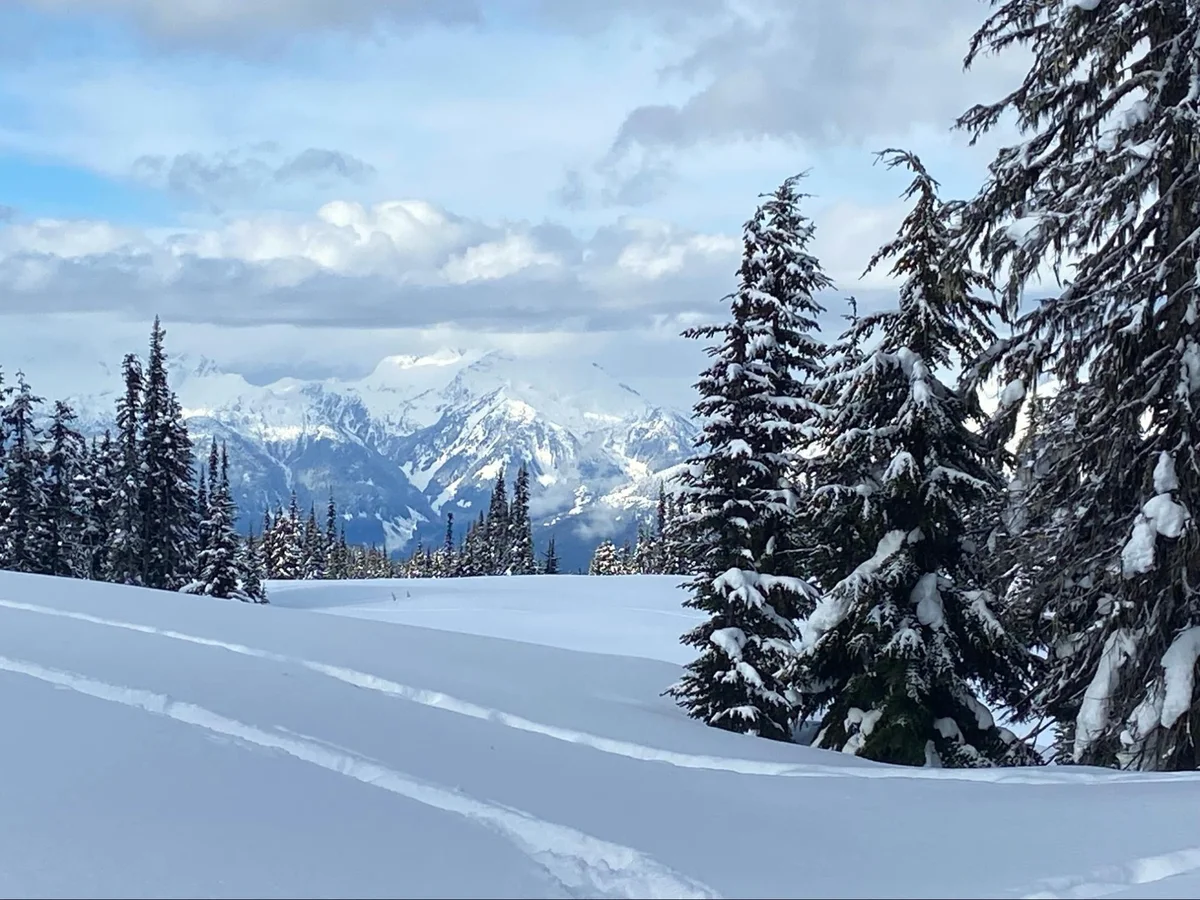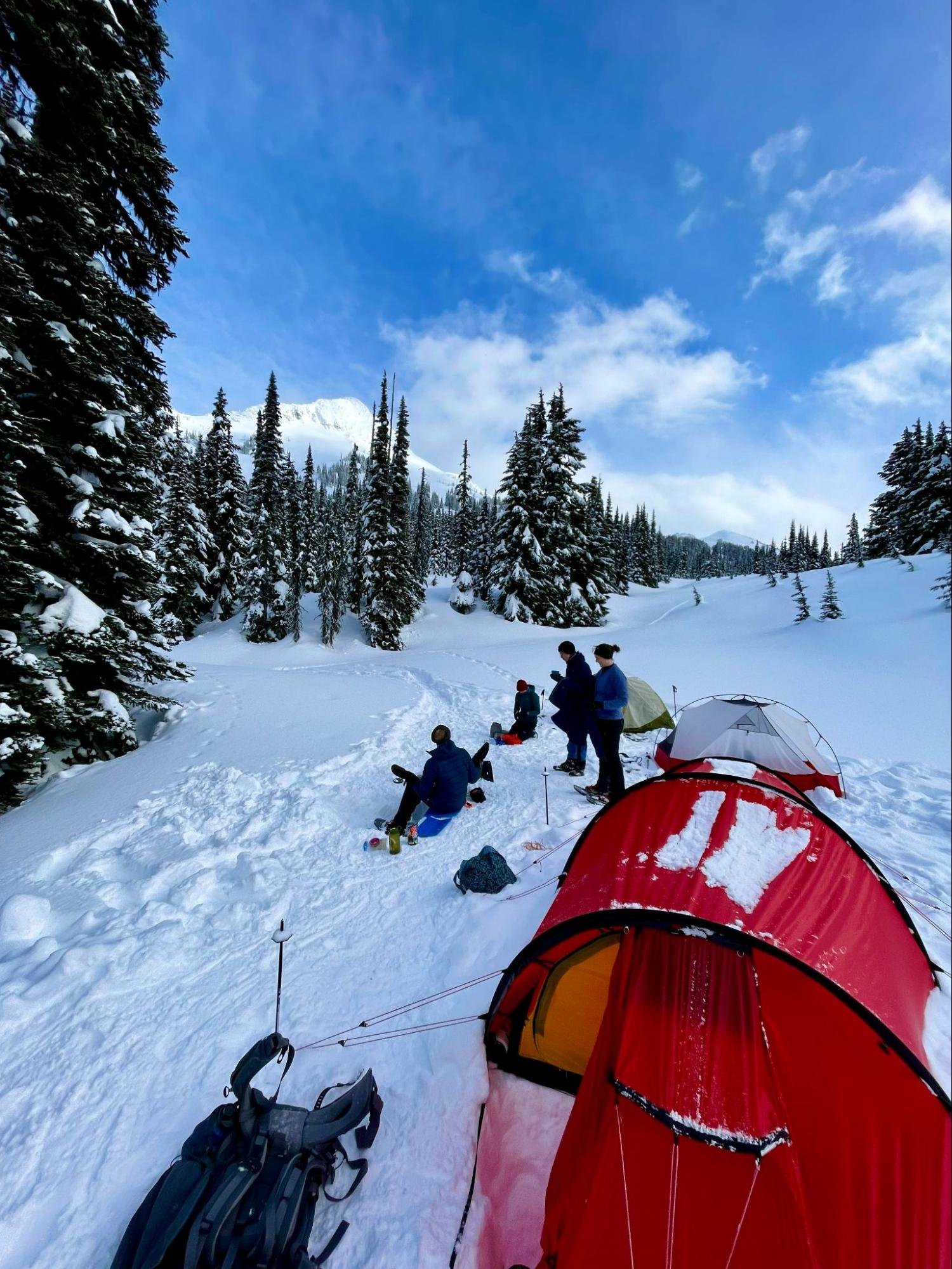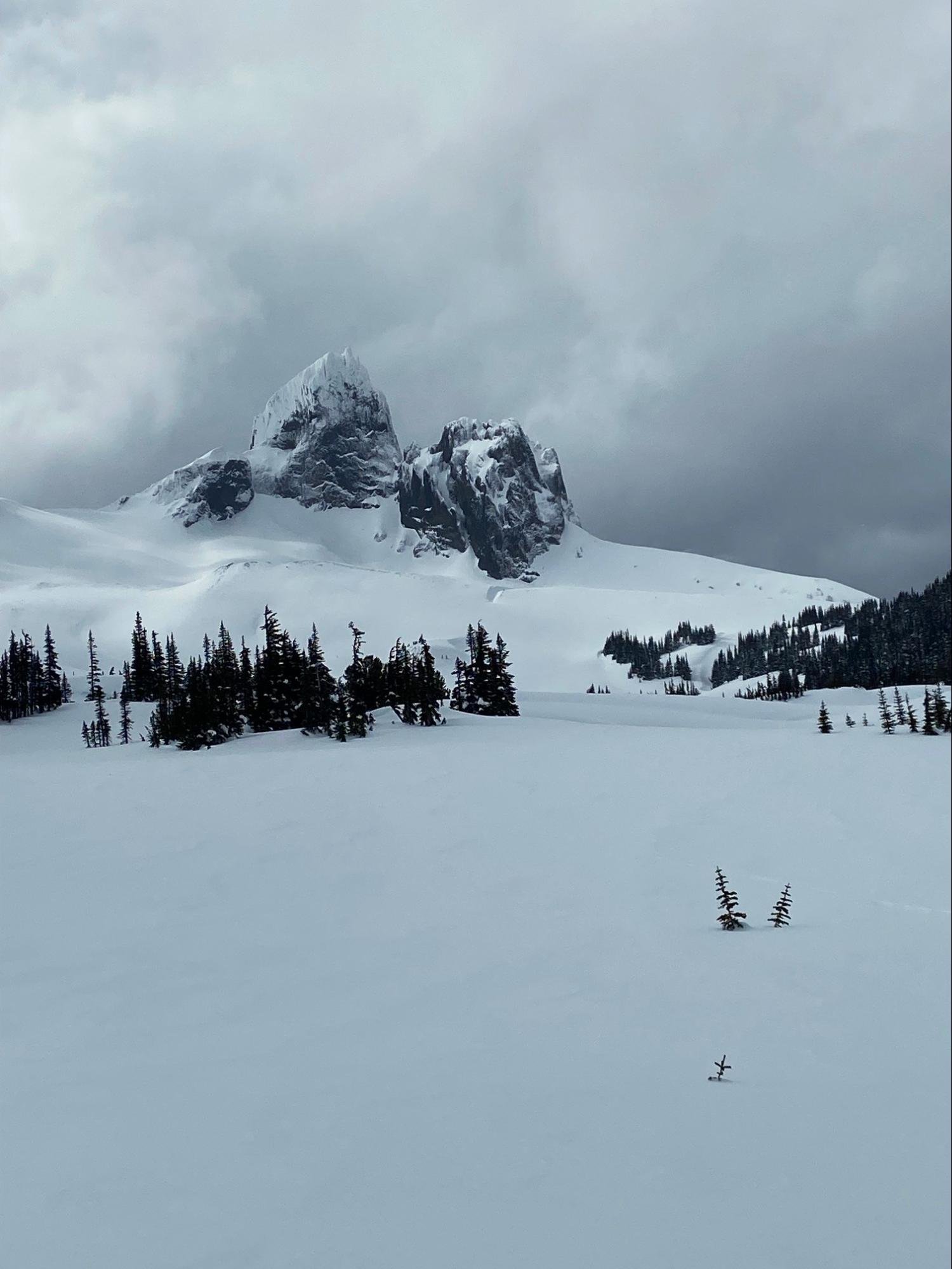
We began hiking from the Rubble Creek trailhead at 11 a.m. on a Saturday. Wet, heavy snow fell around us as we pulled crampons around our hiking boots and began our ascent. The first 7K involved hiking up steep switchbacks on packed snow. As we climbed higher, the trees thinned, and beams of sunlight shone through the gaps in the branches. The wet snowfall turned into light, airy snowflakes as we gained elevation.
This was the start of my first backcountry winter camping trip. On the first day, we planned to hike 16K and gain 1225m of elevation. The second day would be much easier, as we would cover only 7K, most of which would be a descent. We planned a point-to-point hike rather than a loop or an out-and-back; to achieve this, we would park one car at our starting point (the Rubble Creek trailhead) and our endpoint (the Cheakamus Lake Forest Service road).
I quickly learned that one of the most important aspects of winter camping is being flexible with your plans. Before our hike began, we hit our first roadblock — we could only drive 1K up the unplowed 7K Cheakamus Lake Forest Service Road. That meant we would have to hike an extra 6K on the Forest Service Road at the end of our second day. Thankfully, we had planned a short second day.
The first 7K of day one was slow and strenuous. We all breathed a sigh of relief when we reached Taylor Meadows, which meant we had completed most of the elevation for the day. There, the trees opened up and gave way to a sunny clearing covered in powdery snow, deep enough to bury the Taylor Meadows campground kitchen shelters. Rugged snowy peaks surrounded us; our trek through the trees was well worth the view.
We entered Taylor Meadows around 4 p.m., which meant we only had two hours before sunset and 9K left to hike before we reached our planned campsite. As we slowly snowshoed through the vast meadows, we realized we would not make it to our campsite before sunset. We decided to modify our plan and only hike another 4K before setting up camp in the meadow by a patch of trees that would provide shelter from the wind. It was a relief to finally set down my pack and relieve the strain on my back and shoulders. We quickly set up our tents before the sun went down and then put on our headlamps to cook dinner in the dark.
I will admit that I was nervous about winter camping, especially in the BC backcountry. I moved to BC this fall to begin my master’s degree after living my entire life in Atlantic Canada. When I arrived, I was immediately captivated by the vastness of the backcountry. However, the wilderness in BC presents many risks I was unaccustomed to. When preparing for the trip, avalanches, tree wells and large predators were all on my mind. Luckily, I was accompanied by more experienced hikers who were avalanche trained and planned a route that would only cover low-risk avalanche terrain. Even so, it was a challenging trip, and there were times when I questioned whether winter camping was for me.
After sunset on the first day, the real challenges began. As I stood freezing cold in the dark, waiting for our camp stove to melt snow, doubts began to creep in. My fingers and toes were in pain from the cold, and despite feeling sore and tired from all of the hiking we had done, I forced myself to pace around our campsite in an attempt to keep warm. Finally, our water boiled, and we added it to the freeze-dried backcountry meals we had purchased at MEC the day before. After finishing our meal, we drank the remainder of the boiled water, unavoidably mixed with small specks of dirt and conifer needles, but nevertheless, a luxury as we stood there in the cold.
The next morning, we awoke to the sun shining brightly through our tent. We ate breakfast under the gaze of a towering peak shining in the sunlight. Though the second day was mainly downhill, it would prove to be more challenging than the first. Shortly after we left our campsite, the tracks from previous hikers vanished, and we briefly lost the trail. Thankfully, the most experienced hikers among us, who mapped our trip with AllTrails, were able to navigate us back to the trail. This involved hiking unmarked paths up steep inclines in our snowshoes, which greatly slowed our progress and called for numerous breaks.
After we found the trail again, we stopped for lunch at Helm Lake, where we had a perfect view of the magnificent Black Tusk, a jagged volcanic rock part of the Garibaldi Volcanic Belt. After lunch, I felt rejuvenated and ready to tackle the remaining 15K of our hike, most of which would be downhill. The next portion of the hike was the highlight of the trip for me. The sun was shining brilliantly as we traversed flat ground surrounded by majestic snow-capped peaks. Being the only people on the trail, I felt so grateful for the opportunity to peacefully experience my surroundings and enjoy the quiet of a snow-covered landscape.
As we descended, we returned to the thick forest for the remainder of the hike. The descent was steep, and my legs were beginning to feel the effects of carrying a heavy pack. Finally, the path levelled off as we reached the Cheakamus River bridge, a sign we were close to the service road.
We reached the end of the trail at sunset and continued in the dark along the forest service road our car could not travel the day prior. Though the road was relatively flat, and we walked on a path of packed snow, this portion of the hike was the most mentally challenging. Finally, as we descended one final hill, my headlamp lit up our car in the distance, and I felt a sense of elation. We had done it!
If there is one thing I will take with me from this trip, it’s how important it is to appreciate the small moments. I felt so appreciative of warm meals, good conversations and the breathtaking views, all of which made this trip well worth its challenges. At times, I was challenged physically and mentally, but in the end, what I will remember most is the seemingly trivial moments that brought me so much joy and peace.
If you are someone who enjoys long hikes and backcountry camping, this route through Garibaldi might be for you. It provides rewarding views without traversing high-risk avalanche terrain. However, ensure you are adequately prepared for the potential risks before your trip. AdventureSmart BC and Avalanche Canada are great starting places to learn more about winter safety in the backcountry and how to read the avalanche forecast for your area.
Though this experience will undoubtedly challenge you, when you find yourself trekking across a snow-covered valley underneath the staggering Black Tusk, you will surely agree this is a place to be.



